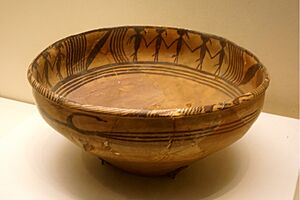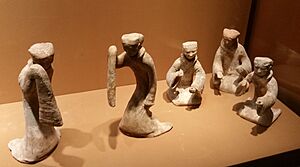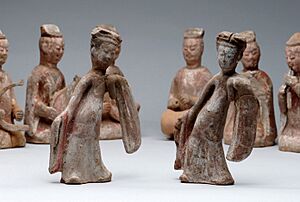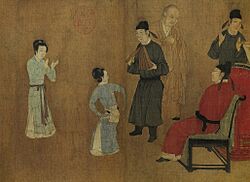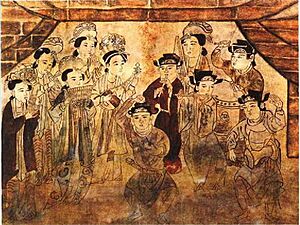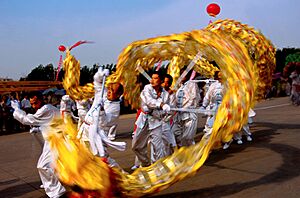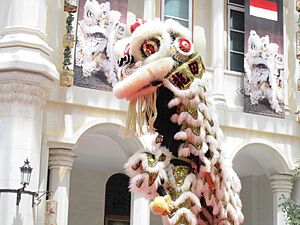History of Chinese dance facts for kids
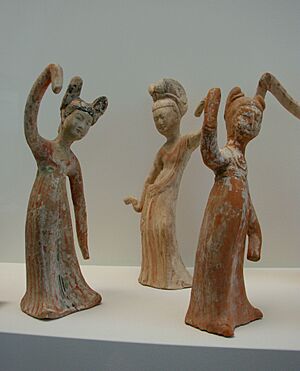
Dance in China has a very long history. People have been dancing in China for over 4,000 years! Early dances were often folk dances or special ritual dances. Some of these even became fancy court dances. The most important early dances were part of rituals and ceremonies. They were called yayue and were performed in the imperial court until the Qing dynasty.
Many different kinds of dances, from popular entertainment to folk dances, have been written about in old Chinese books. Dance became super popular during the Tang dynasty (618–907 CE). Lots of dances were recorded from this time. Later on, dance as a separate art form became less common. Dances often became part of operas instead. Also, when footbinding became more common, female dancing decreased.
Luckily, dance has become popular again in recent times. Today, many people, both regular folks and professionals, enjoy dancing in China.
Chinese dances have been recorded for over 2,000 years. Some dance styles, like dancing with long sleeves, have been around since the Zhou dynasty (around 1045–256 BCE). Famous dances like the Lion dance also come from the Tang dynasty or even earlier. Other dances changed over time, but many were known by the Song dynasty. Even though many Chinese dances are ancient, dance is always changing. New Chinese dances are still being created today!
Contents
Ancient Chinese Dances
Pictures of dancing have been found on Chinese pottery from the Neolithic period (before 2000 BCE). These pictures show people dancing in a line, holding hands. The very first Chinese symbol for "dance" looks like a dancer holding ox tails. An old book from around 239 BCE says that people from the Getian clan would dance in pairs or threes. They held ox tails, stamped their feet, and sang.
Early dances in China were also linked to magic and shamanic rituals. The old Chinese symbol for "sorcerer" or "shaman" (wu) looked like dancing shamans or their sleeves. This means a wu was someone who danced to talk with gods and spirits. Many old records talk about shamans dancing, for example, to make it rain during a drought. There are even mentions of rain dance platforms in ancient texts.
Old Chinese books like the Rites of Zhou (from the 2nd century BCE) describe dances from early times. The most important dances of the Zhou dynasty were called the "Great Dances." There were six of them. They were performed to honor Heaven, Earth, gods, ancestors, or famous old leaders. These six dances were part of a system of court music and dance called Yayue. This system started during the Western Zhou dynasty (1046–771 BCE).
Music and dance were seen as one complete art form. Each dance had its own music. The word for music (樂, yue) could also mean dance. It could even include poetry and other art forms or rituals. These six Great Dances were said to come from the time of six historical or legendary figures:
- Yunmen Dajuan: From the Yellow Emperor's time, performed to honor the sky.
- Daxian: From the Emperor Yao's time, for honoring the earth.
- Daqing: From the Emperor Shun's time, for honoring the Gods of the Four Directions, or the sun, moon, stars, and seas.
- Daxia: In honor of Yu the Great, for honoring mountains and rivers.
- Dahu: From Tang of Shang (end of the Xia Dynasty), for honoring female ancestors.
- Dawu: In praise of King Wu of Zhou, used for ancestor worship.
The Dashao dance was said to be from the time of Emperor Shun. Dancers might have dressed up as birds and animals. One of the oldest documents mentions a ritual where people beat stones as wild animals danced. The famous thinker Confucius really liked this dance.
The Daxia dance honored Yu the Great of the Xia dynasty. He was famous for controlling floods. In this dance, 64 performers danced without shirts, wearing fur caps and white skirts. The dance movements might have copied the hard work of flood control.
These formal dances were either civil (peaceful) or military. In a Civil Dance (文舞), dancers held things like feather flags. Military Dance (武舞) involved waving weapons. The Dawu was an important military dance with six parts. It showed the brave actions of King Wu of Zhou and might have used weapons.
There were also "Small Dances" for younger nobles. These were for smaller ceremonies and rituals. They included:
- Five-Colour Silk Dance: For worshipping the land and grain gods.
- Feather Dance: As a tribute to temples or the Gods of the Four Directions.
- Imperial Dance: For honoring the Gods of the Four Directions or as a rain dance.
- Yak-tail Banner Dance: Performed at special learning places.
- Shield Dance: For military purposes or honoring mountains and rivers.
- Dance of the People: For honoring stars or ancestor temples.
All these dances involved dancers holding objects like feathers or shields. Only the Dance of the People focused on sleeve movements.
Besides formal dances, old books also mention popular and folk dances. One story says that Marquis Wen of Wei found court dances boring. He preferred the lively new music and dances from other states. However, his advisor thought these were too wild.
During the Spring and Autumn period and Warring States period, professional dancing girls appeared in texts. They might have been poor girls who performed in palaces or noble homes. Slaves had also been kept as dancers since the Xia dynasty.
Qin and Han Dynasties (221 BCE – 220 CE)
During the Qin and Han dynasties, the imperial court created the yuefu (meaning "Music Bureau"). This group collected folk music and dances to perform for the emperor. A popular dance of the Han dynasty was the Long Sleeve Dance. We see it in many pictures and sculptures from that time. This traditional dance is still performed today. The sleeves could be long and thin, long and wide, or like the "water sleeves" used in Chinese opera. Old texts also say dancers would bend at the waist while moving their sleeves.
Many dances from this time are mentioned in history books. One story tells of a sword dance performed by Xiang Zhuang at a banquet. He tried to assassinate Liu Bang (who started the Han dynasty). This event led to the "Gong Mo" Dance. "Gong Mo" means "Sir, Don't!" It describes how Xiang Bo blocked Xiang Zhuang's sword to protect Liu Bang. The "Gong Mo" Dance later became known as the Scarf Dance. It was performed with a long scarf in each hand, similar to today's Long Silk Dance.
Liu Bang also liked the war dance of the Ba people, called the Bayu dance. This dance was known by different names later on. Large performances of this dance involved waving weapons with drums and songs in the Ba language.
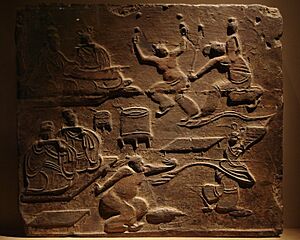
Other dances included the Drum Dance, Bell Dance, Sabre Dance, and mixed couple dances. A writer named Fu Yi described the Seven Tray Dance. This was a mix of acrobatics and dance. The dancer would leap gracefully between trays and drums, getting faster as the dance went on.
During the Han dynasty, a popular show was called baixi (meaning "hundred shows"). It grew from a wrestling game of the Qin Dynasty. These shows featured many Chinese variety arts. They included acrobatics, martial arts, magic tricks, comedy, music, and dance. One writer described dancers dressed as beasts, fish, and dragons.
A famous Han dynasty dancer was Zhao Feiyan. She was a great beauty who started from humble beginnings and became an Empress. She was called Feiyan, or "Flying Swallow," because she was so slender and light on her feet. She seemed to quiver like a flower in the hand. Professional dancers back then had low social status. Many became dancers because they were poor, but some, like Zhao Feiyan, gained higher status by becoming concubines. Another dancer, Wang Wengxu, was forced to be a singer-dancer. She later gave birth to the future Emperor Xuan of Han.
Six Dynasties Era (220–589 CE)
The period after the Han dynasty and before the Sui dynasty was called the Six Dynasties. During this time, Chinese music and dance were greatly influenced by Central Asia. Musical instruments like the pear-shaped pipa and dances like the lion dance might have come to China from Central Asia. Music and dance from places like Kucha and Western Liang (in modern Gansu province) became popular. Western Liang music might have mixed Han Chinese and other styles.
This period had many civil wars and conflicts. China split into many states and dynasties. This caused many Han Chinese people to move south. This move led to a mix of music and dance from the Central Plains with southern traditions. This created a new style called Qingshang music.
When the capital moved to Jiankang (today's Nanjing), music and dance from the Wu region (near the Yangtze River) became popular. These dances included the Qianxi Dance, the Whisk Dance, White Ramie Dance, the Cup Tray Dance, and the Mingjun Dance, which told the story of Wang Zhaojun.
Sui and Tang Dynasties (581–907 CE)
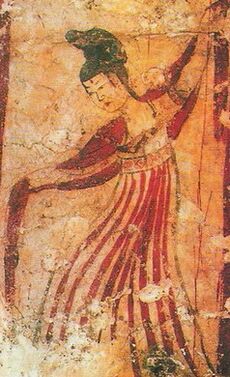
In the late 6th century, Emperor Wen of Sui united China again. The Sui dynasty collected music and dance from different groups in China and from outside. This was put into the "Seven Books of Music." It described music and dance from places like Western Liang, Korea, India, Bukhara, Kucha, and two Chinese styles.
Later in the Sui dynasty, music and dance from Shule and Samarkand were added, making "Nine Books of Music." During the Tang dynasty, under Emperor Taizong of Tang, this grew to ten books. The most popular were Chinese styles and Kuchan music.
These dance collections at the imperial court show how diverse and global Tang dynasty music and dance were. Only two styles were originally Han Chinese. Music and dance from India, Central Asia, Southeast Asia, and other neighboring states were performed in the capital city of Chang'an. Performers and dancers wore their traditional costumes. The Tang court brought together the best dancers from all over. They performed grand dances that mixed elements from China, Korea, India, Persia, and Central Asia.
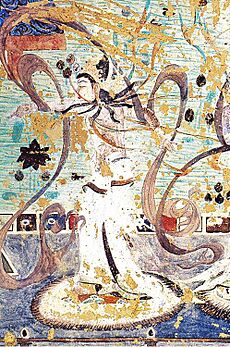
Dances from Central Asia were especially popular. One was the Sogdian Whirling Dance from Samarkand. This dance involved very fast spinning. (Spinning dance moves are still seen among the Uyghur people today.) It's said that An Lushan and Emperor Xuanzong of Tang's concubine Consort Yang also performed this dance.
Another popular dance was the Mulberry Branch Dance from Tashkent. It could be a solo dance with fast drumming. Or, two girls might appear from inside a large lotus flower. There was also a male solo dance called the Barbarian Leap Dance. It was described as a dance by white-skinned people with high noses.
The Tang dynasty was a golden age for Chinese music and dance. Special schools were set up to train musicians and dancers for the imperial court. Emperor Xuanzong of Tang even created the Pear Garden Academy. During his reign, there were about 30,000 musicians and dancers at the court! Most of them specialized in banquet music.
Performances at the Tang court were of two types: seated performances and standing performances. Seated performances were in smaller halls with fewer dancers. They focused on refined artistry. Standing performances had many dancers. They were usually done in courtyards for grand shows.
Standing performances included "The Seven Virtues Dance." This dance celebrated the military victories of Emperor Taizong of Tang. It was performed by 120 dancers in gold armor with spears. It could also be a seated performance with four dancers in red silk robes. Two other major Tang dynasty dances were the Blessed Goodness Dance and The Supreme Original Dance.
Smaller dances, for banquets, were divided into two types: energetic dances and soft dances. Energetic dances were strong and athletic. They included dances from Central Asia like the Whirling Dance and Sword Dance. The Sword Dance was famously performed by Lady Gongsun. Her performance is said to have inspired the famous calligrapher Zhang Xu. Soft dances were gentle and graceful. The Green Waist Dance, a female solo dance, was a soft dance.
Large performances at banquets with singers, dancers, and musicians were called Grand Compositions. These became very elaborate during the Tang dynasty. A famous example is the Rainbow Skirt Feathered Dress Dance. It was choreographed by Consort Yang and set to music by Emperor Xuanzong of Tang himself. This slow, gentle dance could be performed in groups or solo. Dancers wore elaborate costumes. Many of these grand dances stopped after the An Lushan Rebellion, which weakened the state.
During the Sui and Tang dynasties, song-and-dance dramas became popular. Examples included "The King of Lanling," a masked dance honoring a general who wore a mask in battle. Another was "The Dancing Singing Woman," about a wife beaten by her drunken husband. These simple stories are thought to be the early forms of Chinese opera.
Many Tang dynasty dances are described in Tang poetry. Poets wrote about the Whirling Dance, the sword dance, and the White Ramie Dance. They also wrote poems set to dance tunes.
Many dances were recorded in the Tang dynasty, but most were lost after the Tang fell. However, some music and dances were passed on to Japan. They are still kept alive there today as part of gagaku (Japanese court music and dance).
Song Dynasty (960–1279 CE)
After the Tang dynasty, China was divided for a while. Then, the Song dynasty united the country. During the Song dynasty, the practice of footbinding began to spread among wealthy women in China. This practice might have started with female dancers. One story tells of a concubine who bound her feet to dance like a ballet dancer. While it might have started with dance, footbinding restricted women's movement. This, along with other social rules, led to fewer female dancers in later times.
Popular entertainment centers in the Song capital cities were called wazi. These places had theaters where different kinds of entertainment, including dances, were performed. Dances often involved spinning movements. Some Tang dynasty dances developed into "Team Dances" with a main dancer, a presenter, and background dancers and musicians. These dances included singing, monologues, and dialogues.
Many dances familiar today were mentioned in the Song dynasty. Examples include the Flower Drum and the Big-headed Monk dance, where the performer wears a large mask. The Dry Boat Dance, known from earlier times, involved a boy dressed as a girl in a boat-like structure. Folk dance groups often performed these dances during festivals.
In the Song dynasty wazi, various theater forms grew, and Chinese opera began to take shape. Dances became part of longer stories. For example, a sword dance might be followed by a scene showing people's reactions to it. Stories were told, sometimes with songs, in these dance performances.
Yuan to Qing Dynasties (1271–1912 CE)
Chinese opera became very popular by the Yuan dynasty. In the dynasties that followed, different types of opera, like kunqu and Peking opera, developed. Dances became a key part of opera. Opera performers had to be good at dancing. For example, in the Ming dynasty opera The Peony Pavilion, every line of singing had a dance movement. Dances like "Dance Judgment" became opera pieces.
As Chinese opera grew popular, dance as a separate art form became less common. By the Ming dynasty, pure dance was rare, except for folk traditions and festival performances. Female dance performances also declined due to foot-binding and social rules. Later, women were even forbidden to perform in Beijing theaters during the Qing dynasty. So, men took on female roles and dance parts in opera.
However, folk dances remained popular. Many Qing dynasty folk dances were known from earlier times. For example, the yangge dance developed from a Song dynasty dance. Small folk song-and-dance shows became popular in the Qing dynasty, like the Flower Drum and Flower Lantern shows. Some of these folk performances also influenced or became local forms of opera.
Modern Dance in China
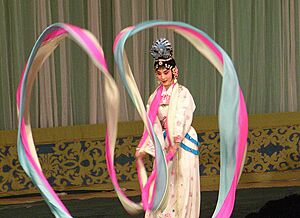
In the early 1900s, there was a push to use old art forms to connect with people. Traditional Chinese dances were changed and promoted. In 1943, the Chinese Communist Party started a new yangge movement. The yangge dance was used to gain support in villages. This new dance was simpler and included socialist ideas.
Western dance forms also became popular in the 20th century. For example, Western ballroom dancing was popular in Shanghai nightclubs in the 1940s. Even early Communist leaders like Mao Zedong and Zhou Enlai enjoyed Soviet-style ballroom dancing. Before this, it was usually not allowed for men and women from respectable families to dance together.
A famous dancer of the 20th century was Dai Ailian. She collected folk dances and created new works based on them. Her dances included Lotus Dance and Flying Apsaras, which was inspired by murals in the Mogao caves. Dai also started the first ballet school in China in 1954.
Today, in the People's Republic of China, new dances are still created based on old forms and folk traditions. While they might use traditional names, these dances seen in theaters and on TV are often modern interpretations of ancient dances, using new choreography. Nowadays, many people in China perform various forms of dancing in public spaces or gardens as a way to exercise together.
Dragon Dance and Lion Dance
Among the most famous Chinese traditional dances are the dragon dance and lion dance. Both dances were known in earlier dynasties in different forms. A type of lion dance similar to today's was described in the Tang dynasty. However, the modern form of the dragon dance might be more recent.
In some of the earliest Chinese dances, performers might have dressed as animals and mythical beasts. During the Han dynasty, some forms of the dragon dance were mentioned. The Dragon was linked to rain. During the Han dynasty, a dance might be performed to ask for rain during a drought. An old Han dynasty text says that clay dragon figures were made, and children or adults would dance. The number, length, and color of the dragons, as well as the dancers, could change depending on the time of year.
In variety shows, performers dressed as creatures like a green dragon playing a flute. There were also acts where fish turned into dragons. Some of these performances are shown in Han dynasty stone carvings. The props used seemed heavy and not like modern dragon dances. Today's dragon dance uses lightweight structures. A dozen or so men manipulate them with poles along the dragon's length. Some dragons can be very long and involve hundreds of performers. There are over 700 different dragon dances in China!
The lion dance might have come from outside China because lions are not native to China. The Chinese word for lion, shi, might even come from the Persian word šer. Detailed descriptions of lion dances appeared during the Tang dynasty. It was seen as a foreign import then, but the dance might have existed in China as early as the third century CE. Some think it came from India or Persia. During the Northern and Southern Dynasties, it was linked to Buddhism.
In the Tang court, the lion dance was called the Great Peace Music. There was a version with five large lions of different colors, each over 3 meters tall. Each lion had 12 "lion lads" and was teased by performers with red whisks. Another version was performed by two people. The Tang poet Bai Juyi described it. Dancers wore a lion costume with a wooden head, silk tail, and furry body. The eyes were gilded with gold, teeth plated with silver, and ears that moved. This form looks like today's Lion Dance.
Lion dances use various instruments like gongs, drums, and cymbals. All the music matches the movements of the dance. There are two main forms of the Chinese lion dance: the Northern Lion and the Southern Lion. The Northern Lion looks more realistic. The Southern Lion is less realistic but seems more powerful. A form of the lion dance is also found in Tibet, where it's called the Snow Lion Dance.
Images for kids


